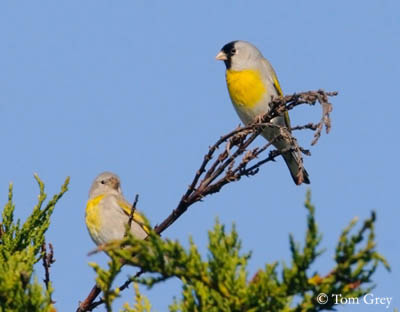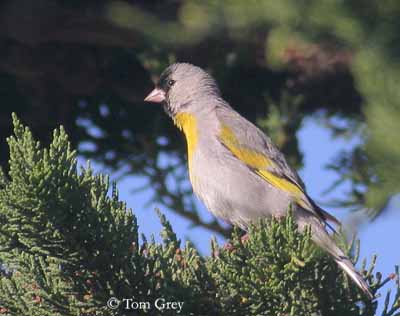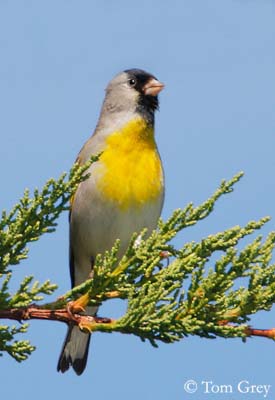
Lawrence’s Goldfinch
Spinus lawrencei
Passeriforme Order – Fringillidae Family
BIOMETRICS:
Length: 10 à 12 cm
Wingspan: 21 cm
Weight: 9 à 14 g
DESCRIPTION:
Lawrence’s Goldfinch is a small songbird, which name commemorates the American ornithologist Georges Newbold Lawrence.
Adult male in breeding plumage has greyish upperparts with often tinged olive green back, turning bright yellow-green on rump. Wings are black with bright yellow wing bars. Outer webs of flight feathers are edged yellow, forming a yellow patch on black wings. Tail is black with white patches on inner webs of tail feathers.
Underparts are bright yellow on chest and upper belly. Sides, flanks, lower belly and vent are pale greyish. Undertail feathers are white.
Head shows black face, with black chin, throat, forehead, lores and crown. Cheeks are pale buffy-grey. Conical bill is pink to greyish-flesh. Eyes are black. Legs and feet are dark.
Adult male in winter plumage is duller, with browner nape and back, and less yellow on chest than in breeding plumage.
Female has entirely grey-brown head, and lacks black face. Yellow areas are duller and white patches on tail are less extensive than in male.
Juvenile is similar to female but with duller colours. Wing bars are buff and upperparts often with indistinct dusky streaks. It has reduced or absent yellow on chest.

VOICE: SOUNDS BY XENO-CANTO
Lawrence’s Goldfinch’s call is a bell-like “tink-ul”, often given in flight. Also a high, thin “dee”, a dry “dri-i-iit”, a quiet, nasal “wheeh” and a rougher “rrehr”.
Song is varied. It is a pleasant tinkling and twittering warbler, often prolonged. Lawrence’s Goldfinch may include mimicries to its song.
HABITAT:
Lawrence’s Goldfinch breeds in arid and open woodlands, often near water and bushy areas, but also in chaparral, coastal scrubs, and rural residential areas near weedy fields and water sources.
It winters in similar habitat, but as in migration, in more open areas such as floodplains, pastures and lowlands with abundant seeds.
RANGE:
Lawrence’s Goldfinch breeds in Central Valley and coastal foothills of California, and in the northern part of Baja California.
Winter range is in southern Arizona, SW New Mexico and northern Mexico. But distribution of Lawrence’s Goldfinches populations often varies within its range from year to year.
BEHAVIOUR:
Lawrence’s Goldfinch feeds mainly on seeds. It forages in tall weeds patches and varied areas where it finds its preferred food. It may forage on foliage, flowers, but also on the ground or from a fence or a wire. It forages during the day and often in mixed flocks. It is gregarious almost all year round.
Lawrence’s Goldfinch gleans seeds perching on a seed-bearing plant, on a nearly plant or other perch. It also feeds on fallen seeds on the ground. When perched, it contorts its body in several ways, or hangs upside down to obtain seeds. For larger seeds, it manipulates them in its bill, removing the shell before swallowing. It doesn’t remove entire fruit from a plant, but it pecks it to get flesh or juice. This species needs water throughout the day, and drinks from quiet streams or any place with freshwater, and it often drinks in pairs or in flocks. This species walks and hops, and climbs on trees. It is an active bird.

Territory is maintained mainly by male’s song and by chasing of intruders. Lawrence’s Goldfinch pair defends the nest-site, chasing other birds from nest-tree, together or not, and there are sometimes physical combat. Intolerance between males occurs in nest area. They challenge each other on the ground or on a perch, but fighting usually occurs in midair. Males face each other in flight, hover a few centimetres apart, and battle with wings, bill and claws. The defeated male leaves the territory.
When alarmed, male performs displays, including facing intruder, elongating body and compressing body feathers, dropping wings, rising and slightly fanning tail. Male may also perform pivoting side to side, while singing strongly. This behaviour displays the male’s black face contrasting with pale bill.
Male is subordinated to female, approaching continuously staying 1-2 metres away, slowly sidling towards her. At this time, it sings or gives courtship calls. Female initiates displays, flying and perching close to it. Both face each other and extend their bodies, uttering soft contacts, until tips of bills meet. They repeat this behaviour several times, until male regurgitates food and female takes it by gaping. Then, both sing, responding to each other before copulation.
Male and female fly around within the nest-site, uttering various notes. Female solicits copulation, flying close to the male, facing it with rising head and tail, and vibrating wings. Then, copulation may occur.
Female may end billing behaviour, giving sharp pecks at male’s head. Then, male uses a special display, retreating a few centimetres and taking a submissive posture with fluffed plumage and flexed legs and neck, and sometimes with dropping and quivering wings.
Lawrence’s Goldfinches are monogamous. They are strongly attached and stay together, male following female in search of nest materials and singing close to her while she builds the nest. Male protects female from other males.
FLIGHT:
Lawrence’s Goldfinch is an agile bird. It performs long undulating flights and high swift bounding flights with rapid wing beats.
REPRODUCTION:
Female Lawrence’s Goldfinch explores potential sites, followed by singing male. Nest is situated in forbs of several drooping outer small branches, and sometimes in a clump of lichens. This species may nest in loose colonies in trees.
Female builds the nest alone, and male stays close to her but doesn’t take part to this work. It follows her while she is searching for nest materials. She builds the nest by weaving materials and anchoring it from branches, and she moves her body against sides to form the cup.
Cup is composed with fine fresh leaves and stems of grasses. It is lined with fine plant fibbers, plant down, feathers, hair, fur, flowers. Female often decorates her nest with lichen, often used as primary material if abundant.
Female lays one egg per day, until 3 to 6 smooth white eggs. Incubation is intermittent after 2 to 3 eggs laid, but becomes continuous when clutch is complete. Incubation lasts about 12 to 13 days, by female. She is fed by the male, and she takes only briefs flights away.

When male brings food to female, it approaches from above, and follows a regular path to her. It sings when is arriving close to her, and female utters calls too. Male feeds her with regurgitated food. Then, both fly off together.
When female returns at nest, she inspects it before sitting in. She leaves the nest only in presence of male, but sometimes she flies off alone, and male searches for her at nest, very disturbed, and tries to regurgitate food to the empty nest. During the day, female preens, arranges nest materials, sleeps and sometimes sings.
Altricial chicks stay low in nest during the first week, but about 8 days after hatching, they can perch on the nest rim. At this time, they have almost complete plumage, except on the head. Female broods them continuously during the first days, and protects them against the sun, spreading her wings to the nest. Male brings food to female which gives it to the young. Food is a sticky paste of regurgitated seeds. Female cleans the nest, removing or consuming fecal sacs.
Young fledge at about 13 to 14 days after hatching. They remain near the nest during the first days, waiting for adults. They leave the nest area one week later, and join adults for feeding.
DIET:
Lawrence’s Goldfinch feeds mainly on seeds of annual plants. In winter, food varies according to the region. They consume salt regularly, and they need water.
PROTECTION / THREATS / STATUS:
This species is a regular target for hawks and jays, but also for Grey Squirrels which threaten the nests.
Lawrence’s Goldfinch could be vulnerable to loss of oak woodlands and chaparral habitats, and to herbicides. The breeding range of the species is threatened by human development and increasing population.
Fr: Chardonneret gris
All : Maskenzeisig
Esp : Dominiquito Gris
Ital : Cardellino di Lawrence
Nd : Maskergeelvink
Sd : Kaliforniensiska
Photographs by Tom Grey
His website :
Tom Grey's Bird Pictures
Text by Nicole Bouglouan
Sources:
FIELD GUIDE TO THE BIRDS OF NORTH AMERICA by National Geographic Society - National Geographic Society - ISBN: 0792274512
A GUIDE TO THE BIRDS OF MEXICO AND NORTHERN CENTRAL AMERICA by Steve N. G. Howell, Sophie Webb - Oxford University Press - ISBN: 0198540124
All About Birds (Cornell Lab of Ornithology)
What Bird-The ultimate Bird Guide (Mitchell Waite)
Wikipedia (Wikipedia, The Free Encyclopedia)